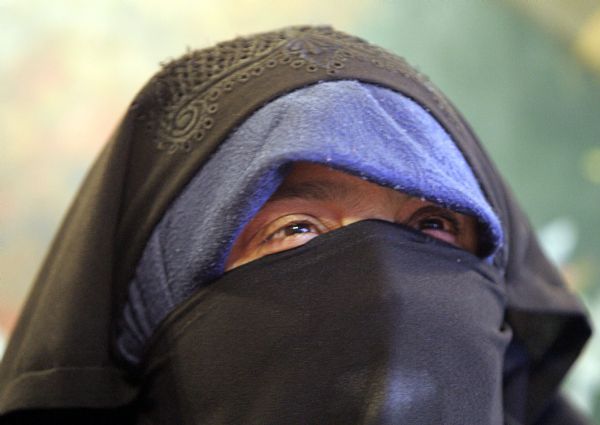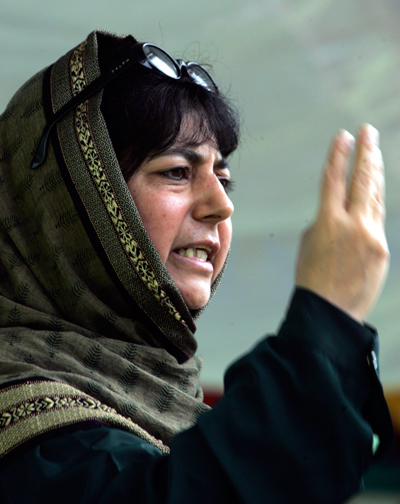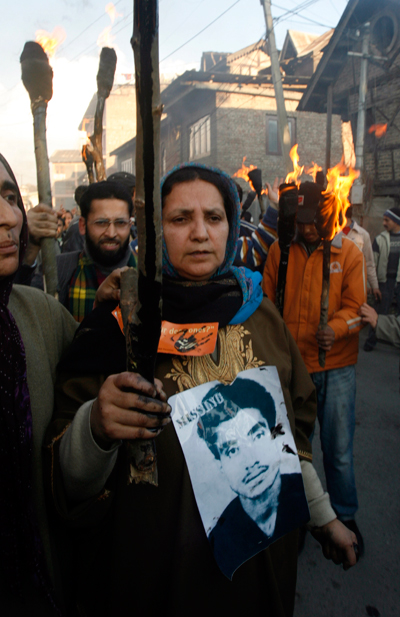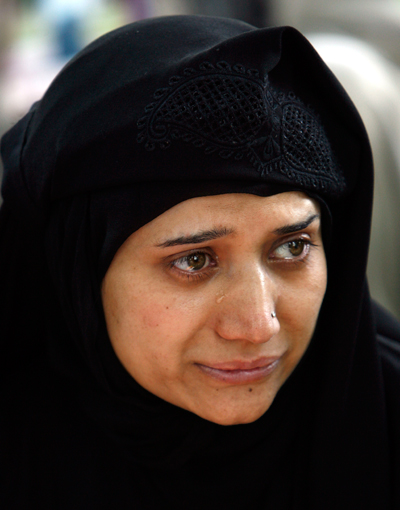A Collage of Her Severally-Inspected Parts
Kashmiri Women Choose Sides and Engage in Politics

In the past 19 years of an armed struggle against India, Kashmir has suffered massive damages of life and property. In the absence of male breadwinners, women of this conservative and patriarchal society were pushed into the public sphere. General and sexual violence by the Indian security forces, in addition to the war bereavements, gave rise to psychiatric and psychosomatic illnesses, especially in women. The turmoil, however, has had a catalytic effect on gender mainstreaming: today there is an increasing clamor for women's participation in the evolving Kashmiri political and economic processes.
Women, Politics & KashmirHistorically women in Kashmir have had a negligible role in politics. At the time of Kashmir's partition into India-administered and Pakistan-administered regions in 1947, only a few women were politically active, mostly due to their family affiliations. This is evident in the likes of Akbar Jehan, wife of the former Prime Minister and popular political leader Sheikh Abdullah, who herself became an activist and a Parliamentarian. Many notable social activists also hailed from political families.
The political world of Kashmir is colored by varied loyalties and competing nationalisms. On one side, there is pro-India politics, which forms the basis of administration and governance for the disputed region. It is peopled by pro-India political parties which may differ on some issues, but owe their ultimate allegiance to India. Then there is separatist politics, which comprises the armed insurgent groups and political fronts. These outfits also have differing motives; some want accession to Pakistan and others seek Independence. The chaotic political horizon boasts a handful of female faces who are prominent, but enjoy little public acknowledgement. Many of them are engaged in separatist politics, while some pursue the pro-Indian agenda. Women's presence in both factions is minimal in comparison to men's. Amidst these two extreme positions, there are also women fighting for social justice and against human rights violations. Although many women are involved in efforts of peacemaking at a grassroots level, the gender dimension is often ignored when it comes to their involvement in significant forums.
Specters on the SpectrumWomen activists play prominent roles across this political spectrum.
Asiya Andrabi, Orthodox Social Activist & Kashmiri Separatist
Asiya Andrabi's severely veiled face represents one end of the political spectrum, manifesting an extreme fringe element of religious orthodoxy wedded to a political cause. Asiya gains much media recognition for her radical agenda and her sound bites spike media ratings. However, she does not entirely represent all women in the separatist movement. There are moderate women separatists like Yasmeen Raja and Fareeda Behenji who pursue political policies sans religious beliefs.
Asiya heads the Dukhtaran-e-Millat (Daughters of the Nation), an organization she initially formed to fight social ills and secure women's rights as conferred on them by Islam. She worked to ban dowry, pornographic films, prostitution, and liquor stores. After 1989, Asiya's organization became politically active for Kashmir's accession to Pakistan, a cause that her incarcerated and formerly-armed separatist husband espouses.
Mehbooba Mufti, pro-India Politician
In 1996, Mehbooba Mufti emerged on the other end of the political spectrum. With her visibly coiffed hair topped by stylish headscarves, she began propagating her father's pro-Indian legacy. She was elected to the legislative assembly, along with Sakina Ittoo, also a politician's daughter, who was later slain by insurgents.
Mehbooba co-founded the People's Democratic Party with her father Mufti Mohammad Sayeed. After winning the elections, her father was propelled into the chief minister's chair. However, winning an election in Kashmir is not necessarily an indicator for popularity or ideological credibility. Kashmiri elections have always been a contentious issue, habitually rigged, with the results more often a technicality than a real democratic harvest. Mehbooba herself acknowledges the voting situation: "10 to 12 percent people do not vote because of their ideological convictions. Between 25 to 30 percent do not vote because of the fear of gun. Then there is a big chunk of 30 to 35 percent of voters who think they will not vote because their votes are not going to be counted." The people who may vote lurk under 50 percent, even when the lesser projections are considered. So it's not surprising that for a woman who burst onto the scene playing the gender and human rights card, Mehbooba was soon reduced to a political rhetoric in a gentler voice.
Parveena Ahangar, Chief, Association of Parents of Disappeared Persons
In 1994, a son of Parveena Ahangar, an unlettered, house-bound mother, disappeared after being arrested by the Indian army. Instead of languishing in private grief, Parveena joined forces with Parvez Imroz, a lawyer-activist, and established the Association of Parents of Disappeared Persons (APDP). APDP mobilizes relatives of the people who have disappeared in custody of the Indian armed forces. Parveena is its chairperson.
Within the Kashmir's pro-India political scene, Parveena's organization carries little weight. She and other members of her organization are constantly beaten, intimidated and harassed. In 1998, APDP suffered a huge setback when an unidentified gunman killed the vice chairperson Halima and her son. The organization suspects pro-government militants, but no one has been arrested so far. APDP continues its mission through hunger strikes, protests and sit-ins. Their efforts have been recognized world over and have garnered a huge moral following. The APDP members meet on the 25th of every month to protest in a sit-in, where little semi-orphan children, half-widows, mothers and other relatives are seen holding placards and wearing headbands with names of their vanished




